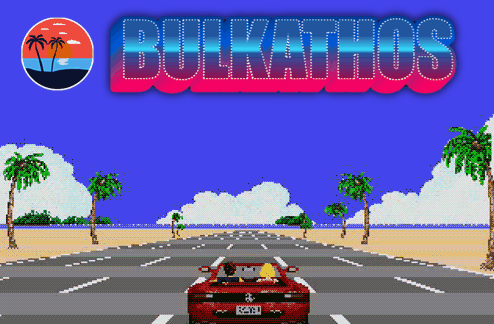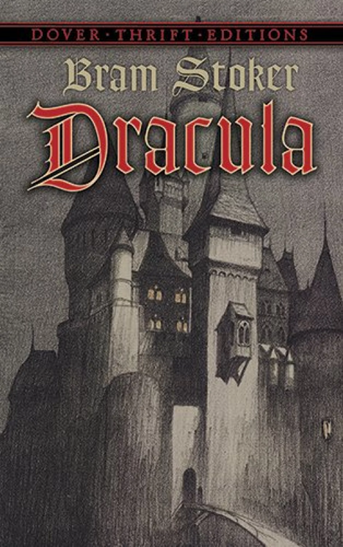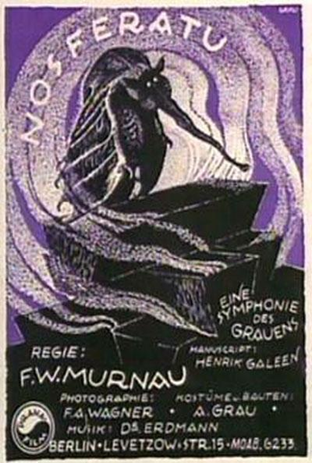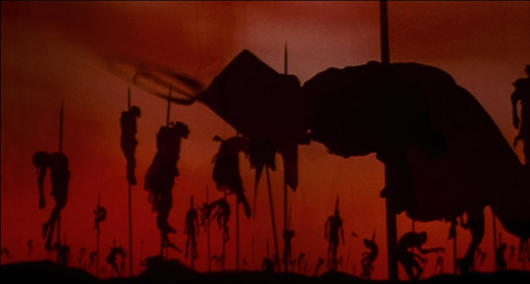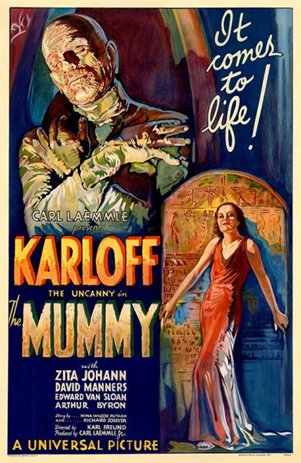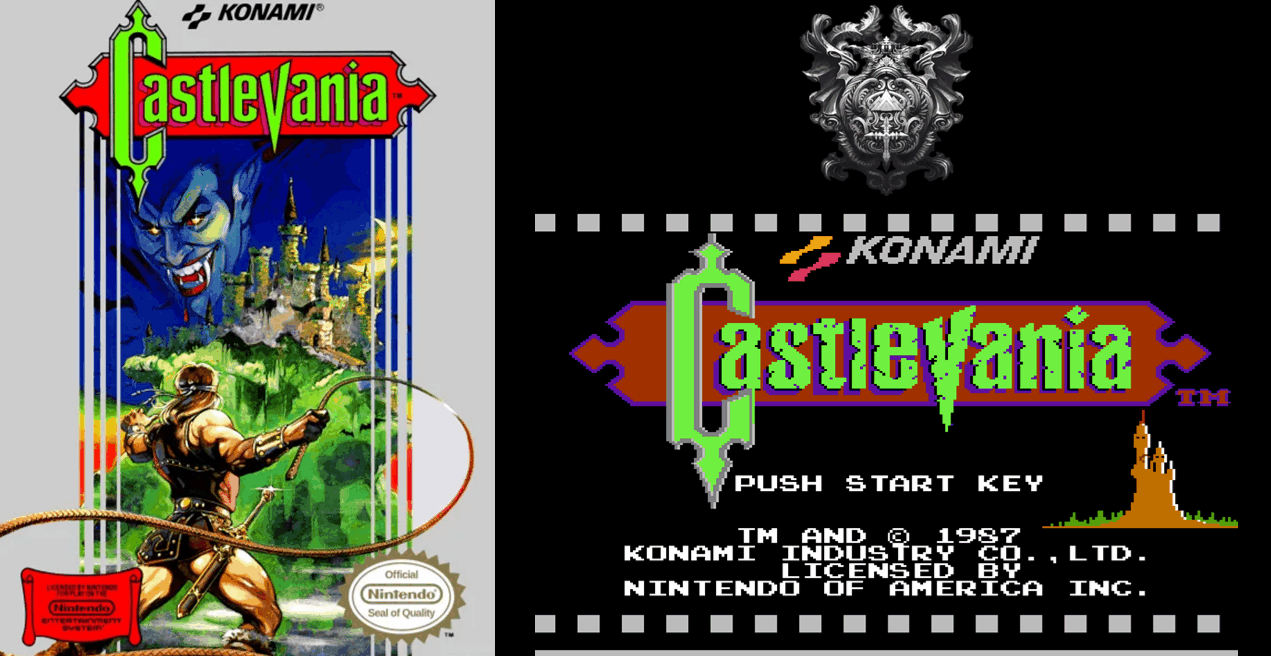
Portada creada del: Gameplay / Cover created from: Gameplay
Saludos comunidad de Geek Zone como siempre es un verdadero gusto compartir en este espacio nuestra pasión por los videojuegos y el día de hoy quiero compartir con ustedes un fragmento de verdadera nostalgia gamer que atesoro con gran cariño y se trata del primer videojuego de terror gótico que pude tener en mis manos: Castlevania!
Greetings Geek Zone community, as always it is a real pleasure to share our passion for video games in this space and today I want to share with you a fragment of true gamer nostalgia that I treasure with great affection and it is the first gothic horror video game that I was able to get my hands on: Castlevania!

El nacimiento de una compañía legendaria: KONAMI/The birth of a legendary company: KONAMI

Konami tuvo su origen en Osaka, Japón y aunque actualmente es una Multinacional en las ramas de los videojuegos, cartas coleccionables, máquinas tragamonedas y figuras coleccionables, para el año de su fundación en 1969 esta compañía se dedicaba a la reparación y venta de Jukebox o mejor conocido aquí como rockolas, así es amigos estos fueron los humildes orígenes de esta gran compañía.
Konami had its origin in Osaka, Japan and although it is currently a Multinational in the branches of video games, collectible cards, slot machines and collectible figures, for the year of its foundation in 1969 this company was dedicated to the repair and sale of Jukeboxes or better known here as jukeboxes, that's right friends, these were the humble origins of this great company.

KONAMI al igual que otras compañías que surgieron en aquellos años como SNK se incorporaron al insipiente mercado de los videojuegos viendo el auge de las salas recreativas a comienzos de los 70´s y posteriormente en los 80s la llegada definitiva del NES como consola doméstica de videojuegos. Los títulos de KONAMI más destacados en aquellos años eran Circus Charlie (1984) y Gradius (1986).
KONAMI, like other companies that emerged in those years such as SNK, joined the nascent video game market, seeing the rise of arcades in the early 70's and later in the 80's the definitive arrival of the NES as a home video game console. The most notable KONAMI titles in those years were Circus Charlie (1984) and Gradius (1986).

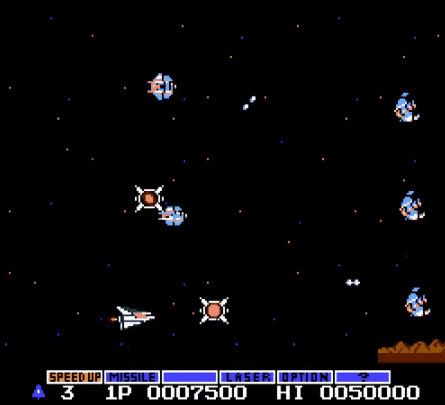
Imagenes tomadas del Gameplay/Images taken from the Gameplay
1986 - Obertura del Terror/Terror Overture: Akumajō Dracula
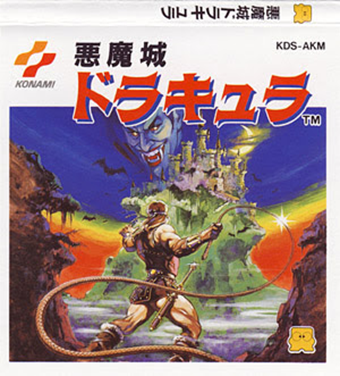
Al igual que SNK, la compañía KONAMI sentía la necesidad de hacer un título que fuera verdaderamente original y no juegos clónicos como los que ya venían creando y sería 1986 cuando la compañía lanzaría el titulo con el cual dejaría una huella perenne en la historia y la cultura gamer: Akumajō Drácula o traducido del japonés: Castillo Demoníaco de Drácula.
Like SNK, the KONAMI company felt the need to make a title that was truly original and not clone games like those they were already creating and it would be 1986 when the company would launch the title with which it would leave a perennial mark on history and culture. gamer culture: Akumajō Dracula or translated from Japanese: Dracula's Demonic Castle.

Captura tomada del gameplay/Screenshot taken from gameplay
Este título salió en 1986 para la consola Famicom Disk System, un periférico del NES pero que nunca salió de Japón y aún así el concepto del juego fue tan exitoso que inmediatamente se pensó en un port para el mercado occidental en el tradicional NES.
This title came out in 1986 for the Famicom Disk System console, an NES peripheral but it never left Japan and yet the concept of the game was so successful that a port for the western market on the traditional NES was immediately considered.
El titulo del juego nos demuestra que KONAMI jamás pretendió ocultar la inpiración de su juego: Akumajō Dracula significa directamente al español "Castillo Demoníaco de Drácula" haciendo directa referencia a la obra literaria de 1897 de Bram Stoker: Dracula.
The title of the game shows us that KONAMI never intended to hide the inspiration of its game: Akumajō Dracula directly means "Demonic Castle of Dracula" in Spanish, making direct reference to Bram Stoker's 1897 literary work: Dracula.
Si bien el arquetipo del Nosferatu o Vampiro fue cimentado por Stoker, este concepto ya existía en obras literarias anteriores como El Vampiro (1819) de John William Polidori y Carmilla (1872) de Sheridan Le Fanu. Stoker tomo los componentes de terror gótico del primer libro, el fuerte componente erótico del segundo libro y lo combina entorno a un enigmático personaje que existió en la vida real: Vlad Tepes.
Although the archetype of the Nosferatu or Vampire was cemented by Stoker, this concept already existed in previous literary works such as The Vampire (1819) by John William Polidori and Carmilla (1872) by Sheridan Le Fanu. Stoker took the gothic horror components of the first book, the strong erotic component of the second book and combined it around an enigmatic character who existed in real life: Vlad Tepes.
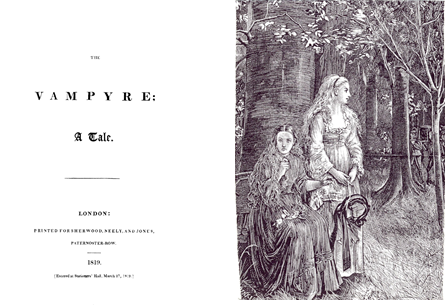
The Vampire 1819 and Carmilla 1872
Vlad Tepes fue un noble del siglo 15 y Rey del principado de Valaquia cuyas hazañas contra los Otomanos así como su crueldad contra ellos le forjaron una reputación como El Príncipe Carmesi, El Caudillo de Sangre o el más conocido: Vald El Empalador.
Vlad Tepes was a 15th century nobleman and King of the principality of Wallachia whose exploits against the Ottomans as well as his cruelty towards them earned him a reputation as The Crimson Prince, The Blood Chieftain or the more well-known: Vald The Impaler.
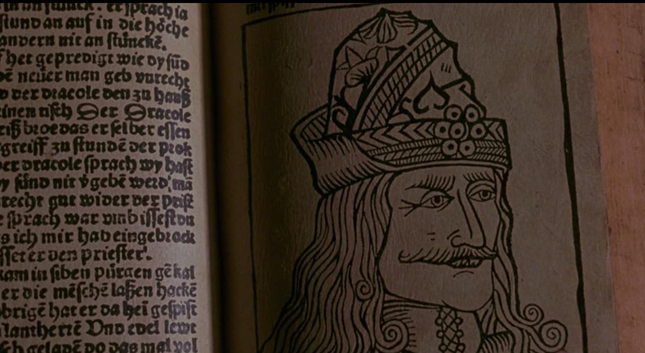
Estos elementos tanto del folclore popular y la literatura victoriana dieron origen a Drácula siendo esta palabra una reminiscencia para el personaje de su caída a la desgracia pues la palabra es su rango como miembro de la Orden Cristiana del Dragón o Dracul.
These elements of both popular folklore and Victorian literature gave rise to Dracula, this word being a reminiscence for the character of his fall to disgrace as the word is his rank as a member of the Christian Order of the Dragon or Dracul.
Desde finales del siglo XIX hasta el siglo XX a casi 100 años desde el primer registro literario del Nosferatu y con la aparición de otros medios de difusión como el cinematógrafo y posteriormente cine, la historia del personaje ha ido variando a lo largo de las décadas siendo el primer registro cinematográfico: Nosferatu Sinfonía del Terror (1922).
From the end of the 19th century to the 20th century, almost 100 years since the first literary record of Nosferatu and with the appearance of other media such as cinema and later cinema, the history of the character has varied over the decades, being the first cinematographic record: Nosferatu Symphony of Terror (1922).
Claramente Nosferatu fue la inspiración para títulos futuros de KONAMI como Castlevania Sinfonía de la Noche, pero las versiones de NES tuvieron su inspiración iconográfica en las películas de Universal y Hammer Films Productions, es decir las versiones de Drácula de Bela lugosi en Drácula (1931) y Christopher Lee en Horror of Drácula (1958).
Clearly Nosferatu was the inspiration for future KONAMI titles such as Castlevania Symphony of the Night, but the NES versions had their iconographic inspiration in the films of Universal and Hammer Films Productions, that is, Bela Lugosi's versions of Dracula in Dracula (1931). and Christopher Lee in Horror of Dracula (1958).
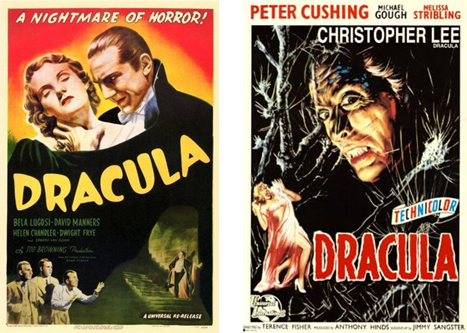
Dracula 1931 & Horror of Dracula 1958
Con estos antecedentes podemos trazar los primeros orígenes y propósitos del villano de Castlevania en las versiones de NES: Con la caída de Constantinopla en el siglo 15 los Otomanos marchan sobre el resto de Europa empezando por los principados de Rumania: Valaquia y Moldavia donde Vald miembro de la Orden Cristiana del Dragón los derrota y crea el "Bosque de los Empalados" como advertencia para sus enemigos ganándose el titulo de Vlad Tepes.
With this background we can trace the first origins and purposes of the Castlevania villain in the NES versions: With the fall of Constantinople in the 15th century the Ottomans march on the rest of Europe starting with the principalities of Romania: Wallachia and Moldavia where Vald is a member of the Christian Order of the Dragon defeats them and creates the "Forest of the Impaled" as a warning to his enemies, earning the title of Vlad Tepes.
Al volver Vlad se entera de la muerte de su amada por una enfermedad, abatido por la noticia, lo injusto del destino y en presencia del Alto Clero culpa a Dios por su destino y es entonces cuando Abjura de la Santa Iglesia, es decir sin perder la fe jura renunciar a sus creencias y su Dios.
Upon returning Vlad learns of the death of his beloved due to an illness, dejected by the news, the unfairness of fate and in the presence of the High Clergy he blames God for his destiny and that is when he Abjures the Holy Church, that is, without losing Faith swears to renounce her beliefs and her God.
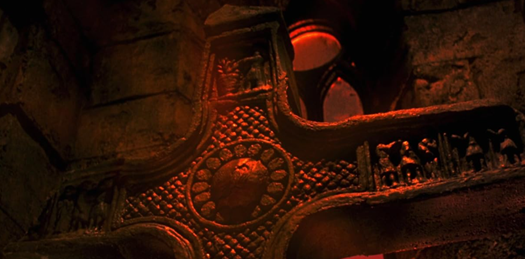
Queda en el terreno de la especulación que entidad atendió esta declaración, si el mismo Dios o El principe de las Tinieblas pero lo cierto es que como favor de las tinieblas o una condena de los altos cielos, Vlad Tepes dejó de ser humano para convertirse en el Inmortal, El Nosferatu o simplemente Drácula.
It remains a matter of speculation which entity attended to this statement, whether God himself or The Prince of Darkness, but the truth is that as a favor from darkness or a condemnation from the high heavens, Vlad Tepes stopped being human to become a the Immortal, The Nosferatu or simply Dracula.
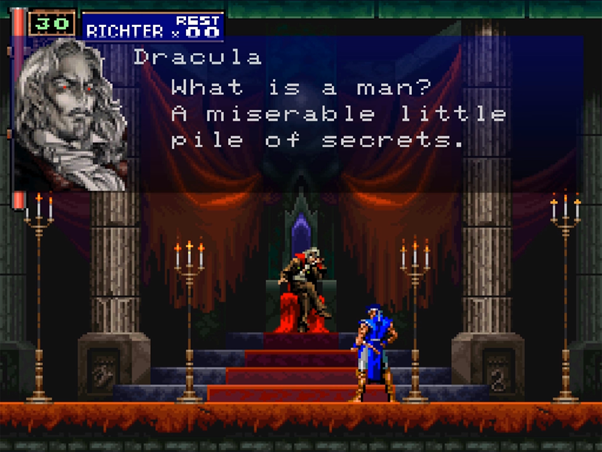
Imagenes tomadas del Gameplay/Images taken from the Gameplay
El Alto Clero ante semejante blasfemia unge con el sagrado deber al Clan Belmont para combatir al Conde Drácula y evitar que esparza la muerte por toda Europa, desde entonces la familia Belmont tiene la divina obligación de enfrentar el mal cada vez que este renace junto al epicentro de su poder: su Castillo.
The High Clergy, faced with such blasphemy, anoints the Belmont Clan with the sacred duty to combat Count Dracula and prevent him from spreading death throughout Europe. Since then, the Belmont family has the divine obligation to confront evil every time it is reborn near the epicenter. of his power: his Castle.
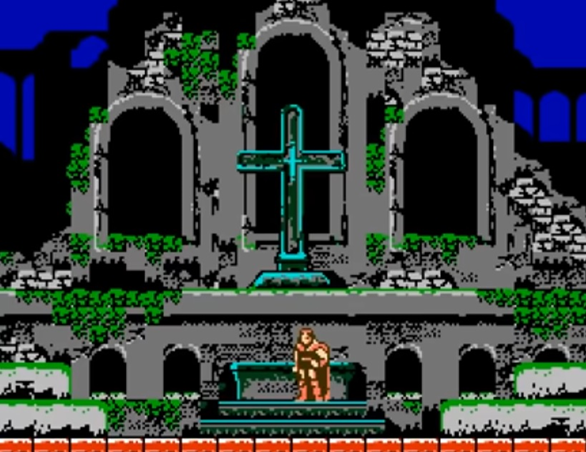
Imagenes tomadas del Gameplay/Images taken from the Gameplay
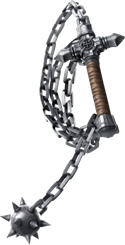
Surge así todo el contexto de la historia de Castlevania para NES en 1987 teniendo como protagonista a Simon Belmont heredero de una antigua reliquia que ha pasado de generación en generación y con el cual hará frente a toda maldad que se le ante ponga: la Vampire Killer.
Thus emerges the entire context of the story of Castlevania for NES in 1987, with Simon Belmont as the protagonist, heir to an ancient relic that has been passed down from generation to generation and with which he will face all evil that comes his way: the Vampire. Killer.
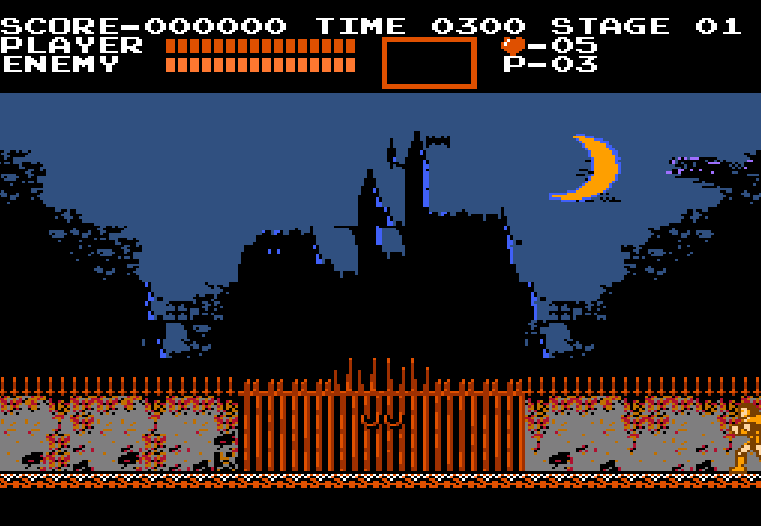
Imagenes tomadas del Gameplay/Images taken from the Gameplay


El Juego/The Game
El juego en esencia es un plataformas lateral que ha diferencias de los títulos que le sucederían este primer título es bastante lineal y termina con un jefe al final del nivel. Los comandos son sencillos saltamos con A, atacamos con B y utilizamos los ítems secundarios con arriba y B, con estos comandos nuestra misión consistirá en atravesar los 6 niveles del castillo hasta llegar a la torre donde nos espera el sirviente de las tinieblas.
The game in essence is a side platform that has differences from the titles that would follow it. This first title is quite linear and ends with a boss at the end of the level. The commands are simple: we jump with A, we attack with B and we use the secondary items with up and B. With these commands our mission will be to cross the 6 levels of the castle until we reach the tower where the servant of darkness awaits us.
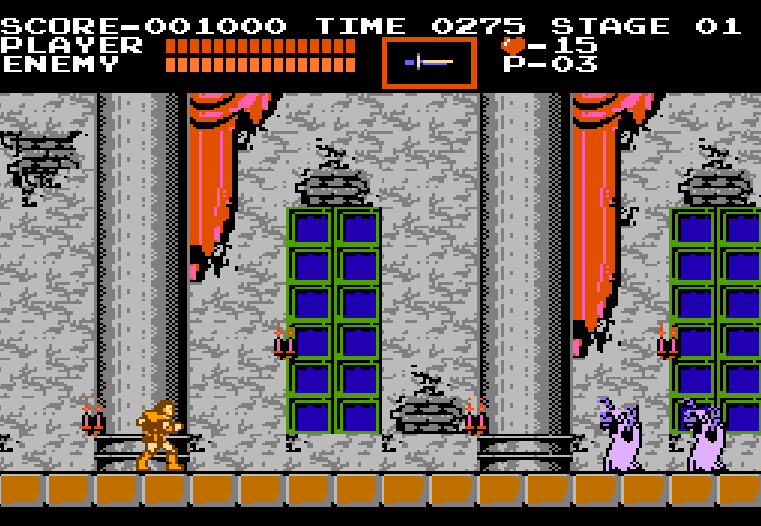
Imagenes tomadas del Gameplay/Images taken from the Gameplay

A lo largo del juego encontraremos potenciadores que le darán un mayor alcance a nuestro látigo y los corazones que encontremos al destruir objetos y enemigos serán la munición para utilizar los objetos secundarios siendo el primero de ellos la daga.
Throughout the game we will find power-ups that will give greater range to our whip and the hearts that we find when destroying objects and enemies will be the ammunition to use the secondary objects, the first of which is the dagger.

Stage 1: Salón Principal/Main Hall
El primer nivel es a las afueras del castillo y el salón principal, donde podemos ver a casi la mayoría del bestiario del juego que van desde los zombies, leopardos negros, murciélagos vampiros, mermaids y medusas a todos ellos habrá que azotarlos a fuerza de látigo para poder avanzar hasta el final del nivel.
The first level is on the outskirts of the castle and the main hall, where we can see almost the majority of the game's bestiary, ranging from zombies, black leopards, vampire bats, mermaids and jellyfish, all of which will have to be whipped. to be able to advance to the end of the level.
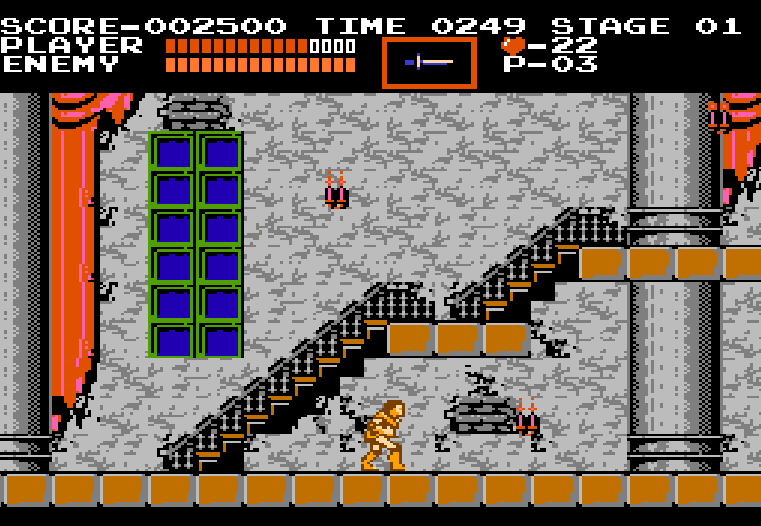
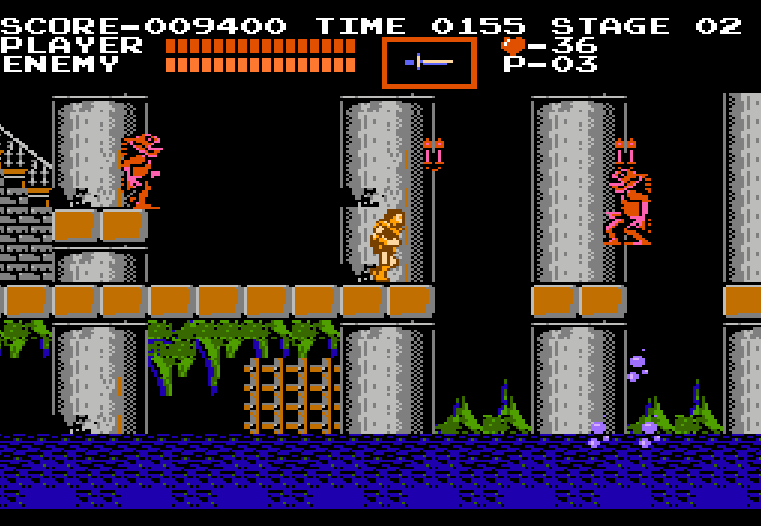
Imagenes tomadas del Gameplay/Images taken from the Gameplay

Boss Fight: Phantom bat!
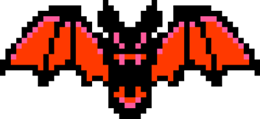
Es el primer jefe que nos encontraremos de camino a la torre del castillo. Se sabe que Drácula durante su época como noble de Valaquia practicó las artes de la alquimia y la nigromancia. Con su transformación, estas habilidades se potenciaron, pudiendo convocar zombies y criaturas de la noche como el murciélago fantasma. Usando el hacha podremos derrotarlo sin mayor dificultad.
It is the first boss that we will encounter on our way to the castle tower. It is known that Dracula during his time as a nobleman of Wallachia practiced the arts of alchemy and necromancy. With his transformation, these skills were enhanced, being able to summon zombies and creatures. of the night like the Phantom bat. Using the ax item we can defeat him without much difficulty.

Imagenes tomadas del Gameplay/Images taken from the Gameplay

Stage 2: La Capilla/The Chapel
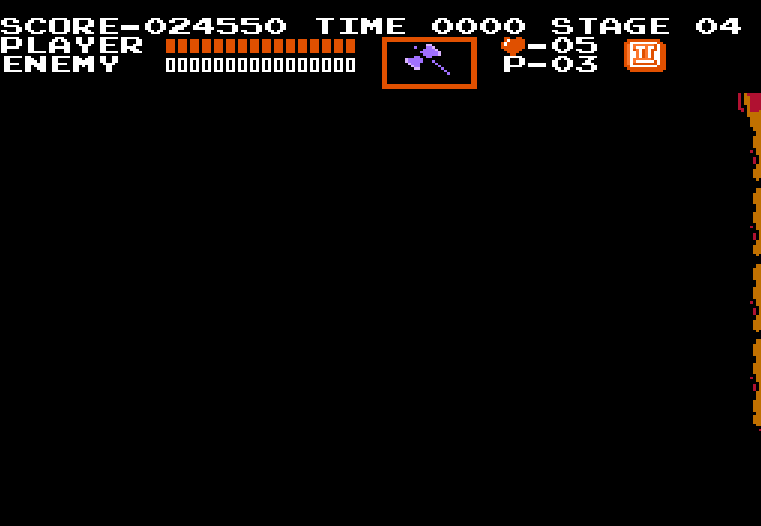
Imagenes tomadas del Gameplay/Images taken from the Gameplay

Cuando acabamos con el jefe de área se nos muestra el avance de Simon Belmont en un mapa, el siguiente nivel es en la Capilla que esta plagado de medusas, murciélagos y un nuevo enemigo el black knight equipado con una fuerte coraza nos va a costar varios ataques derrotarlo. Por suerte el juego nos brinda 2 modificadores: doble y triple lanzamiento, esto nos permite realizar varios ataques con nuestros ítems secundarios, el mejor item aquí es el Boomerang.
When we finish with the area boss we are shown Simon Belmont's progress on a map, the next level is in the Chapel which is plagued by jellyfish, bats and a new enemy, the black knight equipped with a strong armor, it will cost us several attacks defeat him. Luckily the game gives us 2 modifiers: double and triple throw, this allows us to perform several attacks with our secondary items, the best item here is the Boomerang.

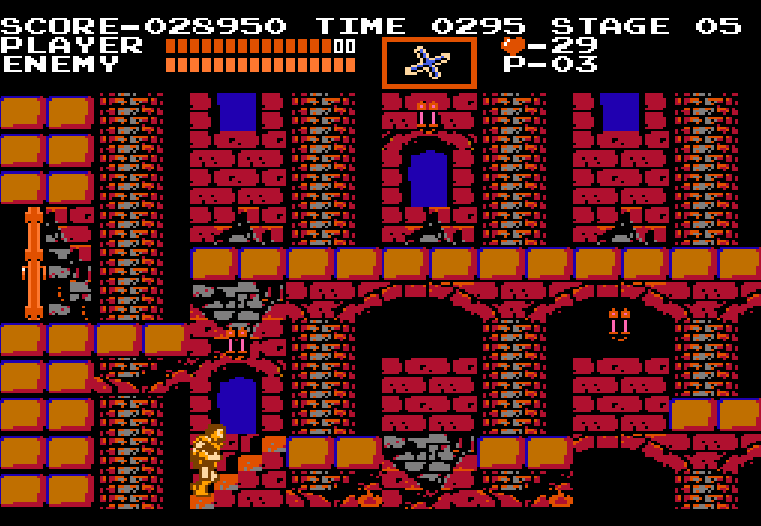
Imagenes tomadas del Gameplay/Images taken from the Gameplay

Boss Fight: Queen Medusa
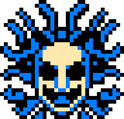
Un monstruo legendario al servicio del Príncipe de la Tinieblas, este jefe suelta serpientes a su paso así que la mejor manera de atacar es agachado y usar el látigo con el boomerang. Ella intentará estar muy cerca de ti por lo que debes mantener la distancia hasta que la hayas derrotado, al derrotarla obtienes el cristal mágico que incrementa toda tu vida.
A legendary monster in the service of the Prince of Darkness, this boss releases snakes in his path so the best way to attack is to crouch and use the whip with the boomerang. She will try to stay very close to you so you must keep your distance from her until you have defeated her. By defeating her you get the magic crystal that increases your entire life.
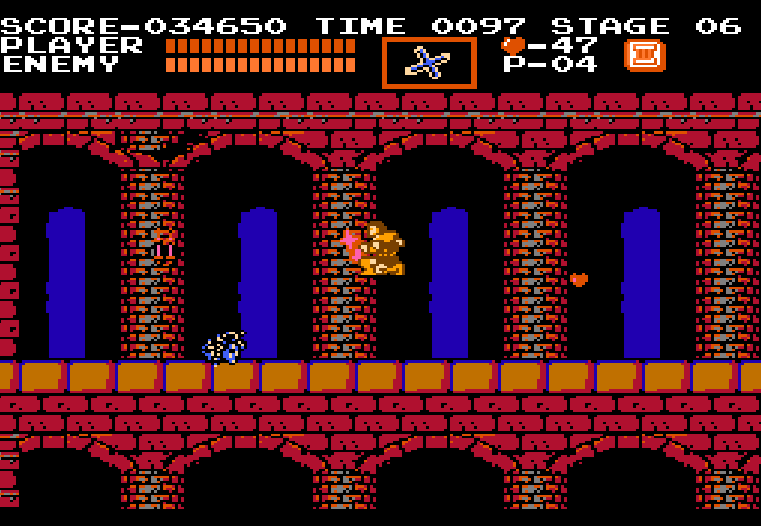
Imagenes tomadas del Gameplay/Images taken from the Gameplay

Stage 3: Ruinas del Castillo/Castle Ruins
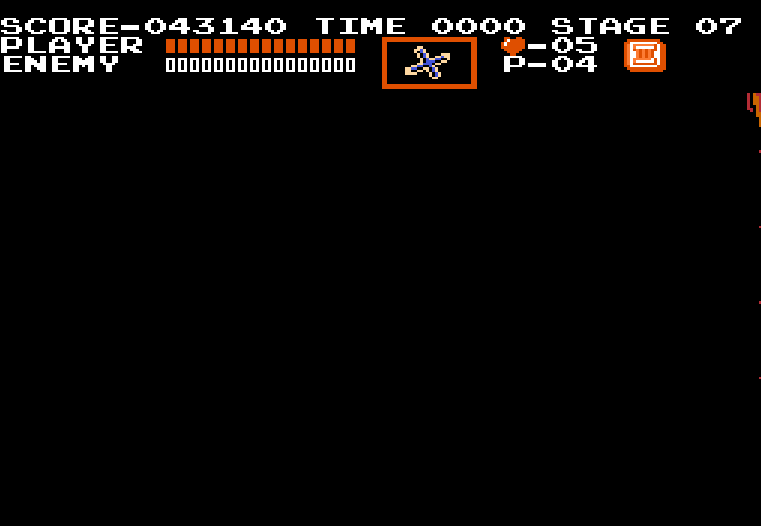
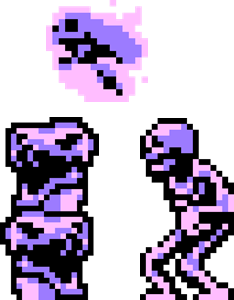
Continuamos nuestro viaje y el 3er nivel son las ruinas del castillo plagado de esqueletos, fantasmas y dragón skull cannon que protegen los mausoleos harán de esta etapa del juego mucho más complicada que las anteriores.
We continue our journey and the 3rd level is the ruins of the castle full of skeletons, ghosts and dragon skull cannon that protect the mausoleums they will make this stage of the game much more complicated than the previous ones.

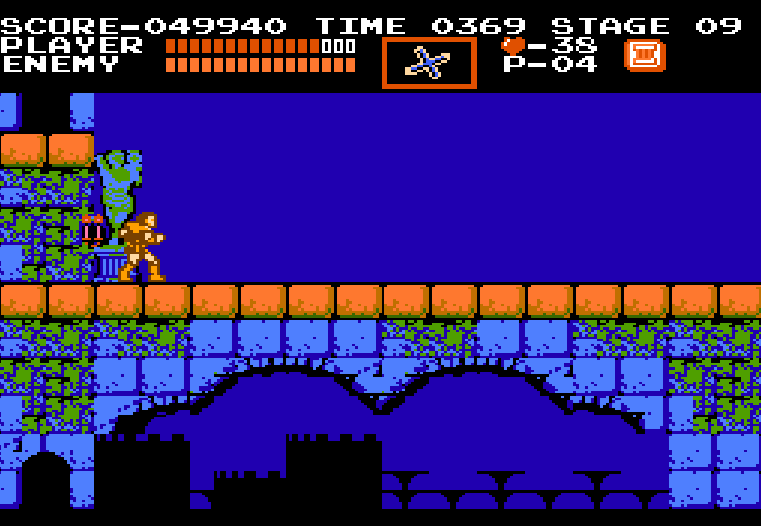
Imagenes tomadas del Gameplay/Images taken from the Gameplay

Una de los elemento que más me llamó la atención del juego es la cantidad de ítems que aparecen, en el tercer nivel encontramos el agua bendita un objeto clásico de todos los Castlevania y también tenemos el elixir de invencibilidad que nos hace invulnerable por unos pocos segundos.
One of the elements that most caught my attention in the game is the number of items that appear. In the third level we find holy water, a classic object in all Castlevania games, and we also have the elixir of invincibility that makes us invulnerable for a few seconds.

Boss Fight: Mummy Man

El jefe final de esta etapa es la Momia en una clara referencia de los creadores del juego por la película The Mummy de 1932 y su gusto por el universo de monstruos cinematográficos de Universal. Este jefe son 2 momias gemelas que te atacan con sus vendajes, aunque no son rápidas al ser 2 se vuelven desafiantes, la mejor estrategia aquí es usar el boomerang teniendo el doble o triple lanzamiento.
The final boss of this stage is the Mummy in a clear reference by the game's creators to the 1932 film The Mummy and their taste for Universal's universe of movie monsters. This boss is 2 twin mummies that attack you with their bandages, although they are not fast as they are 2 they become challenging, the best strategy here is to use the boomerang having the double or triple launch.

Stage 4: Mazmorras Subterráneas/Underground Dungeons

Imagenes tomadas del Gameplay/Images taken from the Gameplay
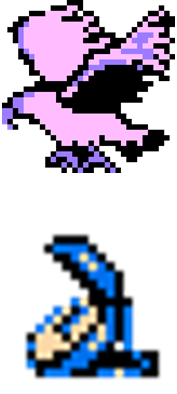
En el 4to nivel descendemos a las mazmorras del castillo, se encuentran inundadas y alli nos esperan los mermaids! Una variante con más vida y más fuertes que los anteriores, también aparecen águilas llevando jorobados que saltan por todo el escenario, la mejor manera de lidiar con ellos es usando el reloj para detenerlos en el tiempo y poder avanzar.
On the 4th level we descend to the dungeons of the castle, they are flooded and there the mermaids are waiting for us! A variant with more life and stronger than the previous ones, also appear eagles carrying humpbacks that jump all over the stage, the best way to deal with them is to use the clock to stop them in time and be able to move forward.
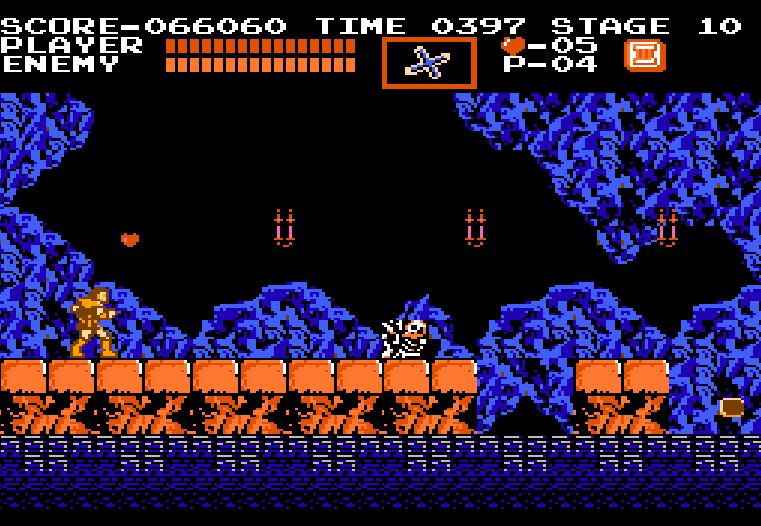

Imagenes tomadas del Gameplay/Images taken from the Gameplay
Boss Fight: Frankenstein & Igor
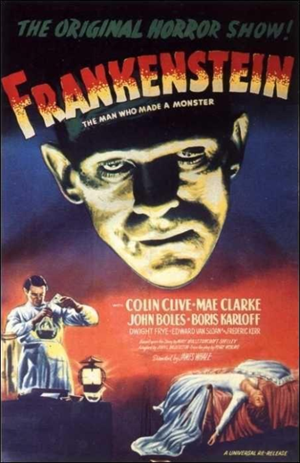
El jefe de esta área es otra referencia del juego a un clásico del sine de terror de los años 30s: Frankenstein de 1931, esta fue la película que llevo a la fama a Boris Karloff y terminaría de sacar de la banca rota a Universal estudios. Esta batalla se compone de 2 jefes: la abominación del Dr. Frankenstein y su fiel sirviente Igor. Esta fue una batalla particularmente difícil ya que no tenía los ítems apropiados así que tocó usar todas nuestras habilidades con el látigo para derrotar a estos engendros.
The boss of this area is another reference in the game to a classic horror movie from the 1930s: Frankenstein from 1931, this was the film that brought Boris Karloff to fame and would ultimately bring Universal Studios out of bankruptcy. This battle consists of 2 bosses: the abomination of Dr. Frankenstein and his faithful servant Igor. This was a particularly difficult battle since we didn't have the appropriate items so we had to use all our skills with the whip to defeat these monsters.
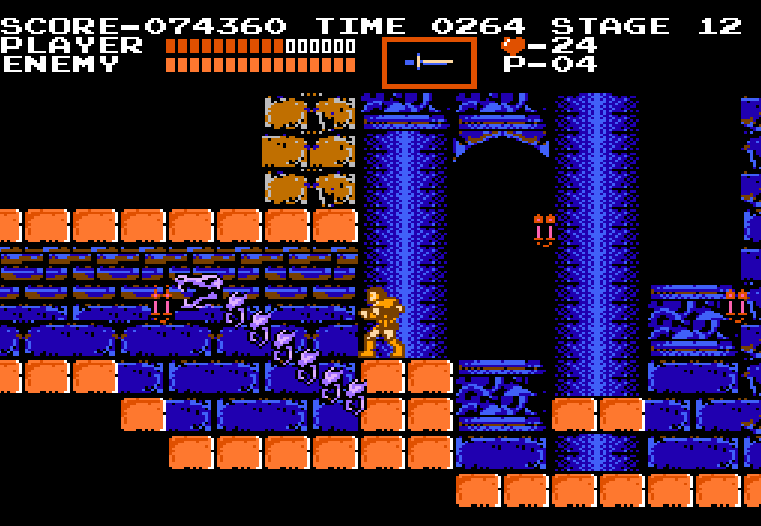
Imagenes tomadas del Gameplay/Images taken from the Gameplay

Stage 5: Torre Principal/Main Building
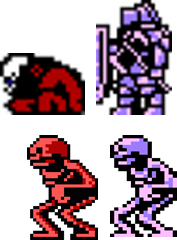
El 5to nivel son las mazmorras del castillo, aquí lo tienen todos esqueletos blancos, esqueletos rojos que se regeneran, jorobados y también nuevos enemigos como el caballero acorazado del hacha. Tendremos que hacer uso de todas nuestras habilidades para lograr abrirnos paso hasta el jefe final.
The 5th level is the castle dungeons, here they all have white skeletons, red skeletons that regenerate, hunchbacks and also new enemies like the armored knight with the axe. We will have to use all our skills to make our way to the final boss.


Imagenes tomadas del Gameplay/Images taken from the Gameplay

Boss Fight: Grim Reaper
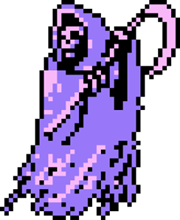
El jefe final es literalmente la mano derecha de Drácula y estamos hablando de La muerte o Grim Reaper y no es de extrañarnos que un Inmortal haga algún tipo de pacto con la Muerte para detenernos. Este enemigo se desplaza por todo el escenario mientras invoca guadañas aleatoriamente que se dirigen a nosotros, la mejor arma secundaria aquí es el boomerang y tener doble o triple lanzamiento para hacer la mayor cantidad de daño y poder derrotarlo antes que alguna guadaña nos alcance.
The final boss is literally Dracula's right hand man and we are talking about Death or Grim Reaper and it is not surprising that an Immortal makes some kind of pact with Death to stop us. This enemy moves around the entire stage while randomly summoning scythes that are directed at us, the best secondary weapon here is the boomerang and having a double or triple launch to do the greatest amount of damage and be able to defeat him before any scythe reaches us.
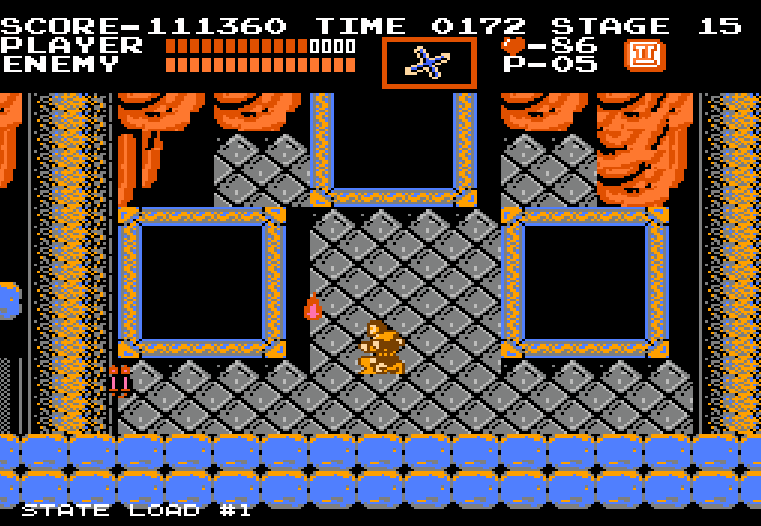
Imagenes tomadas del Gameplay/Images taken from the Gameplay

Stage 6: La Torre del Reloj
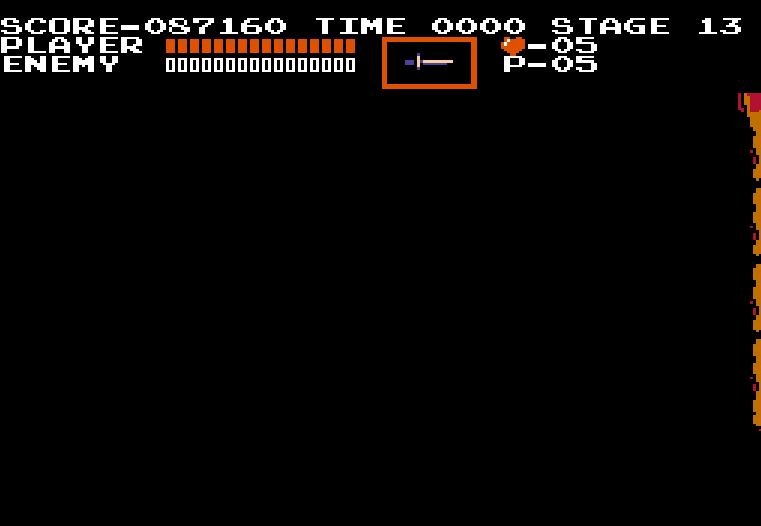
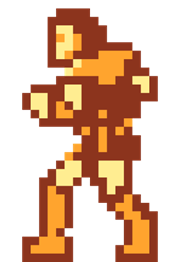
Llegamos al último nivel: la torre del reloj, un nivel que será recurrente en todos los Castlevania posteriores aquí podremos abastecernos bien de salud, corazones y armas para hacer frente al jefe final: Nosferatu Dracula!
We reach the last level: the clock tower, a level that will be recurring in all subsequent Castlevania games, here we can stock up on health, hearts and weapons to face the final boss: Nosferatu Dracula!
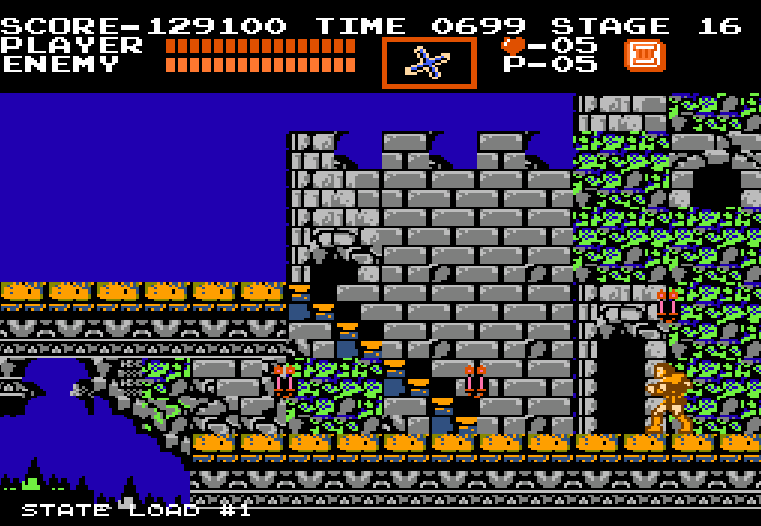

Imagenes tomadas del Gameplay/Images taken from the Gameplay

Final Boss: Dracula

Nosferatu Dracula cumple con todas las casillas canónicas de la obra literaria: un Caballero victoriano de capa negra, con la capacidad de teletransportarse y la única forma de hacerle daño es herir su cabeza. Armados con nuestro boomerang y la Vampire Killer y luego de un gran esfuerzo cercenamos su cabeza! Sin embargo este no es el fin...
Nosferatu Dracula meets all the canonical boxes of the literary work: a Victorian Knight in a black cape, with the ability to teleport and the only way to harm him is to wound his head. Armed with our boomerang and the Vampire Killer and after a great effort we cut off his head! However this is not the end...

Imagenes tomadas del Gameplay/Images taken from the Gameplay
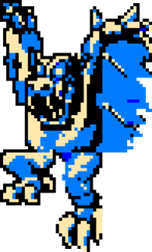
Drácula revela su verdadera forma, una gárgola demoníaca que escupe fuego! Esto deja en claro que su transformación e inmortalidad fueron favores del maligno. La batalla es ardua y encarnizada pero la determinación del Santo Vicario Belmont es superior, su Vampire Killer esta imbuido con el poder de la luz y en un último movimiento de su látigo Nosferatu es derrotado y devuelto al abismo!
Dracula reveals his true form, a fire-breathing demonic gargoyle! This makes it clear that his transformation and his immortality were favors from the evil one. The battle is arduous and fierce but the determination of the Holy Vicar Belmont is superior, his Vampire Killer is imbued with the power of light and in one last movement of his whip Nosferatu is defeated and returned to the abyss!
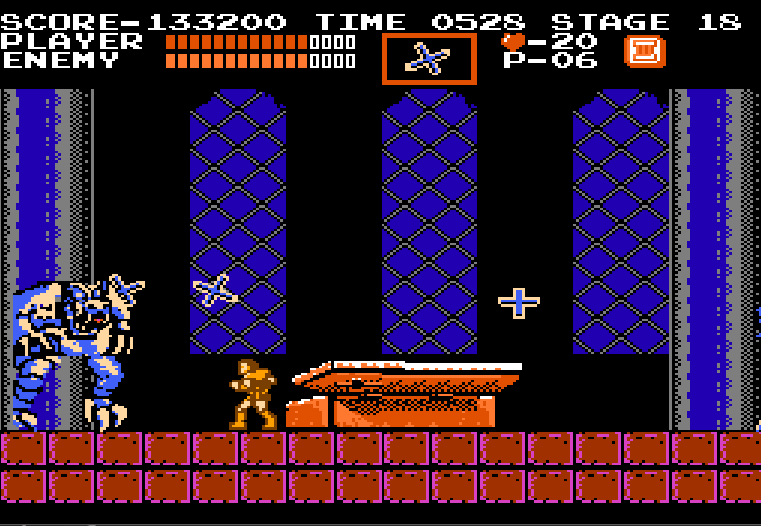
Imagenes tomadas del Gameplay/Images taken from the Gameplay

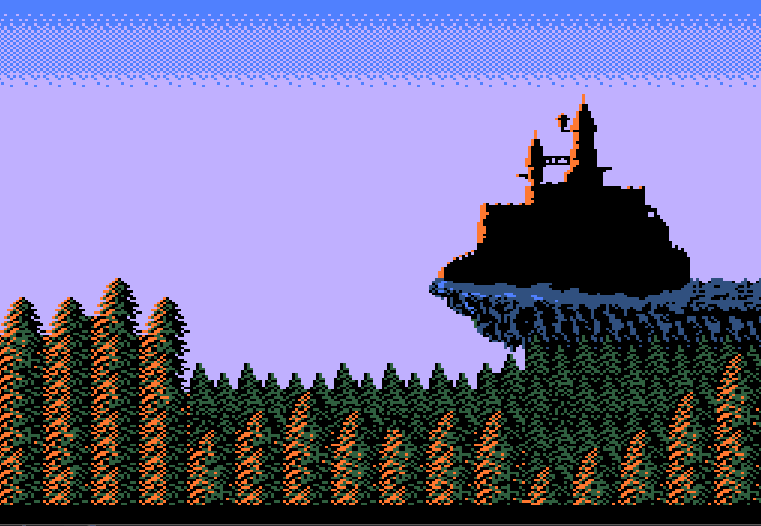
Al final el alba baña las faldas de las colinas de Transilvania, la derrota de Nosferatu significa el fin de la eterna noche y la inevitable llegada de luz del día, se desvanece así el Castillo del blasfemo engendro de la noche mientras que nuestro héroe con la satisfacción del deber cumplido puede descansar de esta eterna lucha contra el mal.
In the end, dawn bathes the foothills of Transylvania, the defeat of Nosferatu means the end of the eternal night and the inevitable arrival of daylight, thus the Castle of the blasphemous spawn of the night disappears while our hero with the satisfaction of duty fulfilled can rest from this eternal fight against evil.

Y bien amigos con este gran juego inmortalizado en la conciencia gamer colectiva termino lo que para mi fue la trilogía de juegos más desafiantes que conocí en la NES: Double dragón, Ninja Gaiden y Castlevania. Espero que haya sido de su agrado, necesitaba hacerle justicia a estos 3 juegos porque soy un hombre de palabra. Nos vemos en una próxima ocasión, les deseo mucha salud y éxitos en sus proyectos. Saludos!
And well friends, with this great game immortalized in the collective gamer consciousness, I finish what for me was the trilogy of most challenging games that I knew on the NES: Double Dragon, Ninja Gaiden and Castlevania. I hope you liked it, I needed to do justice to these 3 games because I am a man of my word. See you next time, I wish you good health and success in your projects. Best regards!
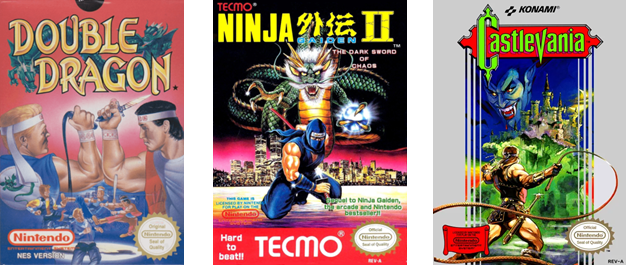
Double Dragon; Ninja Gaiden II & Castlevania

Referencias de imagenes /Image references
Dracula (1897)
The Vampire (1819)
Carmilla (1872)
Vlad Tepes (I) (1992)
Nosferatu: Symphony of Horror (1922)
Dracula (1931)
Vlad Tepes (II) (1992)
Dracula´s Bram Stoker (1992)
The Mummy (1932)
Frankenstein (1931)

All images were taken directly from the gameplay, the gifs were generated using the software screentogif. The translation was done with the Deepl tool.
Todas las imágenes fueron tomadas directamente del gameplay, los gifs fueron generados usando el software screentogif. La traducción se realizó con la herramienta Deepl

Follow me on Hive!/Sigueme en Hive!
